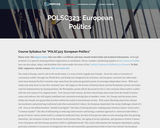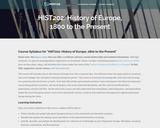
This course will examine European politics, specifically analyzing its process of integration into a supranational entity: the European Union. It will teach the student about key historical events and trends, why Europe is unique, and possible scenarios for Europe's future. It will examine the sovereign state system that emerged from the Wars of Religion, the intricacies of the European Union in the post-World War II environment, major states that make up the EU or play a key role in European politics, and many important contemporary issues that the EU and Europe face. Upon successful completion of this course, students will be able to: summarize the emergence of modern Europe and the challenge of competing European nationalisms and nation states to European peace and prosperity; describe the emergence of the post World War II European peace project that has taken primary form in the development of the contemporary institutions of the European Union while addressing the public and foreign policy issue areas of primary concern to Europeans, including economic, development, and security issues; assess the challenges confronting traditional national state identity among the political communities of West Europe since World War II, which has gained renewed focus with the end of the Cold War and the re-emergence of the question of the relationship of Western Europe to Eastern Europe; analyze the international and national public policy challenges that continue to determine both the policy agenda within the European Union and the institutional evolution of the European Union to meet these challenges. (Political Science 323)
- Subject:
- Political Science
- Social Science
- Material Type:
- Assessment
- Full Course
- Lecture
- Lecture Notes
- Reading
- Syllabus
- Provider:
- The Saylor Foundation
- Date Added:
- 04/29/2019




